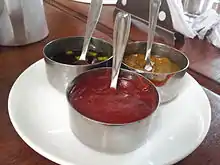Chimichurri
Chimichurri (Spanish: [tʃimiˈtʃuri]) is an uncooked sauce used both as an ingredient in cooking and as a table condiment for grilled meat. A specialty of Argentinian and Uruguayan cuisine,[1] the sauce comes in a green (chimichurri verde) and red (chimichurri rojo) appearance. It is made of finely chopped parsley, minced garlic, olive oil, oregano and red wine vinegar.
.jpg.webp) | |
| Type | Condiment |
|---|---|
| Place of origin | Argentina |
| Main ingredients | finely chopped parsley, minced garlic, olive oil, oregano, red pepper flakes and red wine vinegar |
Etymology
| Look up chimichurri in Wiktionary, the free dictionary. |
The name may be a variant of Spanish chirriburri 'hubbub', ultimately perhaps from Basque zurrumurru 'noise, rumor'.[2] Another theory connects it to Basque tximitxurri 'hodgepodge', 'mixture of several things in no particular order'; many Basques settled in Argentina in the 19th century.[3]
Various, almost certainly false etymologies, purport to explain the name as a corruption of English words, most commonly the name "Jimmy Curry",[4][5] "Jimmy McCurry",[4][6] or "give me curry",[7] but no contemporary documentation of any of these stories has been found.
Preparation
Chimichurri is always made from finely chopped parsley, but other seasonings used vary.[8] Inclusion of red wine vinegar, garlic, salt, black pepper, oregano, red pepper flakes, and sunflower or olive oil is typical (plus a shot of hot water) [8][9] Some recipes add shallot or onion, and lemon juice.[9] Chimichurri may be basted or spooned onto meat as it cooks, or onto the cooked surface of meat as it rests.[9] Chimichurri is often served as an accompaniment to asados (grilled meats).[8] It may be served with grilled steaks or roasted sausages,[1] but also with poultry or fish.
Other uses of the term
In the Dominican Republic, chimichurri or chimi is a hamburger topped with coleslaw and sauces;[10] a sauce somewhat similar to Argentinean chimichurri is called wasakaka.
In the cuisine of León, Mexico, chimichurri is a pizza topping of mayonnaise, mustard, chile de árbol, white vinegar, garlic, oil and salt. This dressing has an orange hue and is very popular in the city.[11]
See also
References
- Joyce Goldstein, The mysterious origins of chimichurri, San Francisco Chronicle (October 5, 2012).
- Merriam-Webster.com Dictionary, s.v.
- Raichlen, Steven (2010). Planet Barbecue!. Workman Publishing Company. p. 159. ISBN 978-0-7611-4801-2.
- Austen Weaver, Tara (2010). The Butcher and the Vegetarian: One Woman's Romp Through a World of Men, Meat, and Moral Crisis. Rodale Books. p. 41. ISBN 978-1-60529-996-9.
- Dobson, Francisco Ross (2010). Fired Up: No Nonsense Barbecuing. Murdoch Books. p. 58. ISBN 978-1-74196-798-2. Retrieved December 6, 2011.
- Cooper, Cinnamon (2010). The Everything Cast-Iron Cookbook. Adams Media. p. 137. ISBN 978-1-4405-0225-5. Retrieved December 6, 2011.
- John Torode in "A Cook Abroad", season 1, episode 3, BBC, 2015, .
- Maria Baez Kijac, The South American Table: The Flavor and Soul of Authentic Home Cooking from Patagonia to Rio de Janeiro, with 450 Recipes (Harvard Common Press, 2003), p. 337.
- Blumer, Bob. "Steak Gaucho-Style with Argentinian Chimichurri Sauce". Food Network. Retrieved September 11, 2017.
- Helen Grave, 101 Sandwiches, ISBN 1782492992
- "La salsa chimichurri de León". Bonito León (in Spanish). January 2, 2019. Retrieved October 25, 2019.
External links
| Look up chimichurri in Wiktionary, the free dictionary. |
| Wikimedia Commons has media related to Chimichurri. |

